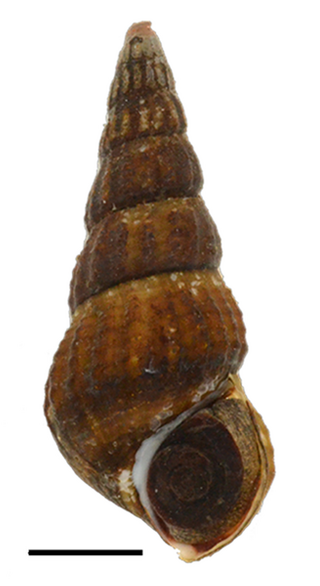
Radix rubiginosa is a species of air-breathing freshwater snail, an aquatic pulmonate gastropod in the family Lymnaeidae, the pond snails.

Anentome helena, common name assassin snail or bumblebee snail, is a species of freshwater snail with an operculum, an aquatic gastropod in the family Nassariidae, most of which are marine.

Clea is a genus of freshwater snails with opercula, aquatic gastropod mollusks in the subfamily Anentominae of the family Nassariidae, a family, almost all of the rest of which are marine.

Indoplanorbis is a genus of air-breathing freshwater snail. Its only member species is Indoplanorbis exustus, an aquatic pulmonate gastropod mollusk in the family Planorbidae, the ram's horn snails. The species is widely distributed across the tropics. It serves as an important intermediate host for several trematode parasites. The invasive nature and ecological tolerance of Indoplanorbis exustus add to its importance in veterinary and medical science.

Brotia pagodula is a species of freshwater snail with an operculum, an aquatic gastropod mollusk in the family Pachychilidae.

Clea bockii is a species of freshwater snail with an operculum, an aquatic gastropod mollusk in the family Buccinidae, the true whelks, most of which are marine.

Tylomelania towutica is a species of freshwater snail with an operculum, an aquatic gastropod mollusk in the family Pachychilidae.

Neripteron violaceum is a species of brackish water snail, an aquatic gastropod mollusk in the family Neritidae, the nerites.

Clithon diadema is a species of brackish water and freshwater snail with an operculum, a nerite. It is an aquatic gastropod mollusk in the family Neritidae, the nerites.

Brotia herculea, common name the giant tower cap snail, is a species of freshwater snail with an operculum, an aquatic gastropod mollusc in the family Pachychilidae.

Thiara cancellata is a species of freshwater snail, a gastropod mollusk in the family Thiaridae.

Clithon lentiginosum is a species of a freshwater snail with an operculum, a nerite. It is an aquatic gastropod mollusk in the family Neritidae, the nerites.

Clithon mertonianum is a species of a freshwater snail with an operculum, a nerite. It is an aquatic gastropod mollusk in the family Neritidae, the nerites.

Neripteron auriculatum is a species of brackish water and freshwater snail, an aquatic gastropod mollusk in the family Neritidae, the nerites.

Neritona juttingae, also known as the King Koopa Nerite Snail, is a species of a freshwater snail, an aquatic gastropod mollusk in the family Neritidae.

Vittina coromandeliana, also known as Neritina coromandeliana, is a species of a freshwater snail, an aquatic gastropod mollusk in the family Neritidae.

Vittina turrita is a species of aquatic snail, a gastropod mollusk in the family Neritidae.

Vittina waigiensis, commonly known as the red racer nerite or the gold racer nerite, is a species of a freshwater, brackish water, or marine snail native to the Philippines and Indonesia. It belongs to the family Neritidae. Red racer nerites have colorful shells that display extremely variable patterns, which makes them popular in the aquarium trade. They are also known as zebra nerites, along with other species of nerite snails with similar shell patterns.-

Brotia armata is a species of freshwater snail with an operculum, an aquatic gastropod mollusk in the family Pachychilidae.

Sulcospira tonkiniana is a species of freshwater snail with an operculum, an aquatic gastropod mollusk in the family Pachychilidae.



















